Ever wondered if being called a “bad apple” means someone thinks you’re spoiled fruit?
A person whose negative behavior or influence can harm or corrupt an entire group, similar to how one rotten apple can spoil the whole batch.
Have you ever been puzzled by this fruity accusation? It’s a common English idiom that has nothing to do with your grocery shopping habits.

This guide will unpack the true meaning behind “bad apple,” clear up misunderstandings, and provide practical examples so you can use it with confidence.
We’ll also explore related expressions, ensuring you’ll never confuse your rotten apples with your black sheep again.
Core Meaning of “Bad Apple”
A “bad apple” is someone who negatively influences a group of otherwise good people. It’s like having one rotten piece of fruit in a basket—left unattended, it can spoil the rest.
When you hear someone say, “He’s a bad apple in the department,” they usually mean one individual is creating a toxic atmosphere or bringing down overall morale.
This idiom appears in workplace settings, social circles, and even in families. Wherever there’s a group dynamic, there can be a “bad apple” who disrupts harmony.
Why This Idiom Is Misunderstood
For those new to English idioms, “bad apple” might sound like a simple observation about spoiled fruit. In reality, it’s a metaphor for anyone whose actions or attitudes harm the collective environment.
The confusion often arises because the literal image—a piece of fruit gone bad—doesn’t immediately connect to a troublesome person.
Yet once you see how one person’s negativity can spread like mold through a basket of apples, the metaphor becomes clear.



Always look for the figurative meaning in idioms! No one’s actually talking about fruit when they mention a ‘bad apple’!
Quick Everyday Life Example
Imagine you’re part of a local community group planning a charitable event. Everyone is enthusiastic, volunteers are eager to help, and the overall energy is positive.
But then there’s Carl, who constantly criticizes every suggestion and complains about small details. Carl’s behavior starts to drain the group’s energy, making meetings less productive.
He’s the “bad apple” in this scenario—his persistent negativity could spoil the collective spirit if it isn’t addressed. Just like a rotten fruit, Carl’s attitude can lead others to lose motivation or begin complaining themselves.
Medieval to Pop Culture
The “bad apple” idiom has been around for centuries.
Here are a few interesting points about its evolution:
- Early Usage: References to “bad apples” were found in moral or religious teachings, often illustrating how a single corrupt individual could affect an entire community.
- 19th Century Nursery Rhyme: The concept gained further traction in nursery rhymes, embedding the phrase in children’s literature and everyday speech.
- 1970s Pop Culture: The Osmonds had a famous song titled “One Bad Apple,” which helped popularize the idiom in modern culture.
- Contemporary Settings: Today, you’ll see the term in newspapers, on talk shows, and in casual conversation, all pointing to a single negative influence in a group.
Real Case: The Enron Scandal
A notorious example of “bad apples” is the Enron scandal.
A few key individuals engaged in unethical financial practices that led to one of the most dramatic corporate collapses in history.
Though Enron was a large company with many employees, those few who falsified documents and inflated earnings were the “bad apples” who ultimately brought down the entire organization.
This case serves as a cautionary tale: a handful of unethical decisions can create a domino effect that ruins reputations and livelihoods.
Find the Bad Apple
Whether at work or in social groups, a negative individual can undermine the entire environment. When multiple people get along, positivity tends to flourish.
However, one “bad apple” can erode that atmosphere with constant complaints, passive-aggressive remarks, or disruptive behavior.
Workplace Case: Mark’s Impact
Let’s say your office has ten employees who genuinely support one another. They share ideas, solve problems, and maintain a friendly atmosphere.
Enter Mark. He complains about trivial issues, criticizes people behind their backs, and frequently spreads rumors.
Suddenly, team members become cautious about sharing ideas, worried Mark will twist their words or ridicule their suggestions.
Productivity drops because nobody wants to collaborate, and morale falls as the pleasant atmosphere slips away.
Mark is the “bad apple” in this setting, affecting everyone around him like a piece of spoiled fruit in an otherwise fresh batch.
How to Handle a “Bad Apple”
1. Identify the Core Issue
Is the person simply having a bad week, or is their negativity a pattern? Separate temporary stressors from ongoing problematic behavior.
2. Encourage Open Communication
Sometimes, the “bad apple” doesn’t realize how they’re affecting others. Discuss concerns privately and diplomatically, offering solutions or compromise.
3. Set Clear Boundaries
If negative behavior persists, define the consequences. That might involve team members refusing to engage in gossip or management intervening with official warnings.
4. Foster a Positive Culture
A group that consistently highlights achievements and supports one another tends to be more resilient.
When positive norms are the standard, a “bad apple” either changes or stands out even more clearly, prompting quicker resolution.
Similar & Opposite
Learning related idioms can broaden your vocabulary and help you communicate nuances. Below are a few handy phrases to keep in mind.
Similar Expressions
- Rotten Apple: This is almost identical in meaning to “bad apple,” emphasizing the idea that one person’s negativity can spoil the group’s vibe.
- Black Sheep: Used when someone in a family or group is considered an outsider or a source of shame, though it doesn’t always imply negative influence.
- Sour Grapes: This phrase describes someone who belittles something they can’t have, often out of envy.
Opposite Expressions
- Good Egg: Refers to a person who is kind, helpful, and generally uplifting.
- White Sheep: This is sometimes used as a direct contrast to the “black sheep,” though it’s less common. It implies someone who is positively distinct rather than negative or problematic.
Related Idiom
Another idiom close to “bad apple” is “toxic person.”
While a “bad apple” can influence a group negatively, a “toxic person” focuses more on the individual’s harmful impact on others’ emotional well-being.
They often manipulate, belittle, or sow discord. In many cases, the terms overlap, as both describe individuals who degrade morale or create conflict.
For example, a “toxic person” in a social circle might always shift blame onto others, or they might make subtle digs that lower people’s self-esteem.



Like a “bad apple,” they can eventually erode the unity and trust in a group if they remain unchecked.
Pop Quiz: Check Your Idiom Skills
Bad Apple

Conclusion
The idiom “bad apple” vividly describes someone whose negativity can spoil an entire group—just like one rotten apple affecting the rest.
Remember:
- A “bad apple” can appear in any setting—work, community groups, or social circles.
- Recognize that their behavior is more than just a personal quirk; it can truly affect everyone else.
- Address the issue by setting boundaries and maintaining a culture of support.
- Related idioms include “toxic person,” “rotten apple,” “black sheep,” and the more cheerful “good egg.”
- Historical events like the Enron scandal remind us how a few unethical actions can bring down a whole organization.



From old teachings to pop songs, the idea still resonates because one person can damage team spirit if ignored.
Learning idioms like this helps you sound more natural and handle group situations with confidence. Bookmark this post and drop a comment below! 🍎









Comment